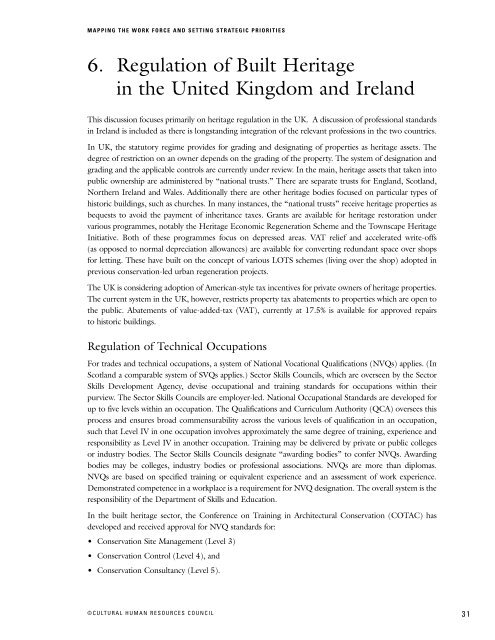Human Resources in Canada's Built Heritage Sector: Mapping the ...
Human Resources in Canada's Built Heritage Sector: Mapping the ...
Human Resources in Canada's Built Heritage Sector: Mapping the ...
- No tags were found...
Create successful ePaper yourself
Turn your PDF publications into a flip-book with our unique Google optimized e-Paper software.
MAPPING THE WORK FORCE AND SETTING STRATEGIC PRIORITIES6. Regulation of <strong>Built</strong> <strong>Heritage</strong><strong>in</strong> <strong>the</strong> United K<strong>in</strong>gdom and IrelandThis discussion focuses primarily on heritage regulation <strong>in</strong> <strong>the</strong> UK. A discussion of professional standards<strong>in</strong> Ireland is <strong>in</strong>cluded as <strong>the</strong>re is longstand<strong>in</strong>g <strong>in</strong>tegration of <strong>the</strong> relevant professions <strong>in</strong> <strong>the</strong> two countries.In UK, <strong>the</strong> statutory regime provides for grad<strong>in</strong>g and designat<strong>in</strong>g of properties as heritage assets. Thedegree of restriction on an owner depends on <strong>the</strong> grad<strong>in</strong>g of <strong>the</strong> property. The system of designation andgrad<strong>in</strong>g and <strong>the</strong> applicable controls are currently under review. In <strong>the</strong> ma<strong>in</strong>, heritage assets that taken <strong>in</strong>topublic ownership are adm<strong>in</strong>istered by “national trusts.” There are separate trusts for England, Scotland,Nor<strong>the</strong>rn Ireland and Wales. Additionally <strong>the</strong>re are o<strong>the</strong>r heritage bodies focused on particular types ofhistoric build<strong>in</strong>gs, such as churches. In many <strong>in</strong>stances, <strong>the</strong> “national trusts” receive heritage properties asbequests to avoid <strong>the</strong> payment of <strong>in</strong>heritance taxes. Grants are available for heritage restoration undervarious programmes, notably <strong>the</strong> <strong>Heritage</strong> Economic Regeneration Scheme and <strong>the</strong> Townscape <strong>Heritage</strong>Initiative. Both of <strong>the</strong>se programmes focus on depressed areas. VAT relief and accelerated write-offs(as opposed to normal depreciation allowances) are available for convert<strong>in</strong>g redundant space over shopsfor lett<strong>in</strong>g. These have built on <strong>the</strong> concept of various LOTS schemes (liv<strong>in</strong>g over <strong>the</strong> shop) adopted <strong>in</strong>previous conservation-led urban regeneration projects.The UK is consider<strong>in</strong>g adoption of American-style tax <strong>in</strong>centives for private owners of heritage properties.The current system <strong>in</strong> <strong>the</strong> UK, however, restricts property tax abatements to properties which are open to<strong>the</strong> public. Abatements of value-added-tax (VAT), currently at 17.5% is available for approved repairsto historic build<strong>in</strong>gs.Regulation of Technical OccupationsFor trades and technical occupations, a system of National Vocational Qualifications (NVQs) applies. (InScotland a comparable system of SVQs applies.) <strong>Sector</strong> Skills Councils, which are overseen by <strong>the</strong> <strong>Sector</strong>Skills Development Agency, devise occupational and tra<strong>in</strong><strong>in</strong>g standards for occupations with<strong>in</strong> <strong>the</strong>irpurview. The <strong>Sector</strong> Skills Councils are employer-led. National Occupational Standards are developed forup to five levels with<strong>in</strong> an occupation. The Qualifications and Curriculum Authority (QCA) oversees thisprocess and ensures broad commensurability across <strong>the</strong> various levels of qualification <strong>in</strong> an occupation,such that Level IV <strong>in</strong> one occupation <strong>in</strong>volves approximately <strong>the</strong> same degree of tra<strong>in</strong><strong>in</strong>g, experience andresponsibility as Level IV <strong>in</strong> ano<strong>the</strong>r occupation. Tra<strong>in</strong><strong>in</strong>g may be delivered by private or public collegesor <strong>in</strong>dustry bodies. The <strong>Sector</strong> Skills Councils designate “award<strong>in</strong>g bodies” to confer NVQs. Award<strong>in</strong>gbodies may be colleges, <strong>in</strong>dustry bodies or professional associations. NVQs are more than diplomas.NVQs are based on specified tra<strong>in</strong><strong>in</strong>g or equivalent experience and an assessment of work experience.Demonstrated competence <strong>in</strong> a workplace is a requirement for NVQ designation. The overall system is <strong>the</strong>responsibility of <strong>the</strong> Department of Skills and Education.In <strong>the</strong> built heritage sector, <strong>the</strong> Conference on Tra<strong>in</strong><strong>in</strong>g <strong>in</strong> Architectural Conservation (COTAC) hasdeveloped and received approval for NVQ standards for:• Conservation Site Management (Level 3)• Conservation Control (Level 4), and• Conservation Consultancy (Level 5).©CULTURAL HUMAN RESOURCES COUNCIL31










